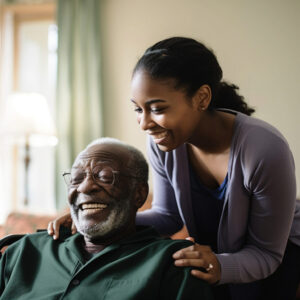Healthy Aging Part 11: Caregiving
By Robin Bush, ISR Communications
We all care – about family, friends, and our communities.
Our willingness and desire to care may be something we are born with or may be something we learn as we interact with others. Our lifetime experience of caring for others and being cared for forms the foundation for those times in our lives when we are called on to assume the role of caregiver for someone.
Caregivers are all around us in every segment of the population. Men and women are both likely to be caregivers. In 2020, the number of unpaid family givers was 53 million, and rising as our population ages, according to the National Alliance on Caregiving. 39% of caregivers are born between 1946 and 1964, 29% between 1965 and 1980, and 23% between 1981 and 1996 (from AARP.org).
In the US, we have a nationwide shortage of paid caregivers, meaning more often, caregiving falls to family members or friends. Caregivers may support those with chronic or long-term medical conditions, emotional, behavioral, or mental health conditions, or short-term illnesses. Even though we have experienced and shown caring throughout our lives, we must learn how to be caregivers. It’s a role that frequently evolves as the care receiver’s situation changes and may often be demanding. Many juggle multiple responsibilities of jobs, simultaneous needs of multiple generations, and personal mental and physical health.
Caregiving often requires sacrificing personal time, hobbies, money, vacations, fitness, and even job advancement. Most unpaid caregivers are untrained and consumed by daily tasks of preparing food, cleaning, dispensing medications, assisting with physical needs, driving, errands, appointments, engagement, interaction with medical teams, and even advocacy. They frequently miss the essential component of caregiving — caring for their body, mind, and spirit by eating well, being active, connecting with others, and taking time for themselves.
Caregiving can be stressful and exhausting, but it can also bring joy. Caregiving to someone loved is an honor. It can be a way to give back to elders for all they have given. Caregiving may also be a way to mend relationships and open the door to reconnection within families. It can also open compassionate conversations between caregiver and receiver that soothe sorrows and fears and process traumatic events. It can awaken long-forgotten memories through the use of music. It can be an opportunity to connect with other caregivers and find support through support groups or new friends to talk with who can relate to each other’s experiences, even as unique as each caregiver’s situation is.
For years, it was assumed the stresses of caregiving were linked to increased mortality rates for the caregiver, but new research by Johns Hopkins offers a positive surprise: Family caregivers may live longer. Looking at six years of health data for 3,503 caregivers and an equal number of non-caregivers, researchers found that those who regularly tended to a family member’s needs enjoyed a nine-month life expectancy—even if they felt some stress and strain. The researchers also saw no differences in chronic health issues between the two groups.
David L. Roth, Ph.D., director of the Johns Hopkins Center on Aging, says, “In many cases, caregivers reported receiving benefits like enhanced self-esteem, recognition and gratitude from their care recipients.”
Everyone’s caregiving is different, but knowing you are not alone is essential. You may find it difficult to ask for help, but Island Senior Resources’ Specialists can help you navigate the days ahead. Call 360-321-1600. We are here for you.
Resources:
The Surprising Health Bonus of Caregiving | Johns Hopkins Medicine
Taking Care of Yourself: Tips for Caregivers | National Institute on Aging (nih.gov)

